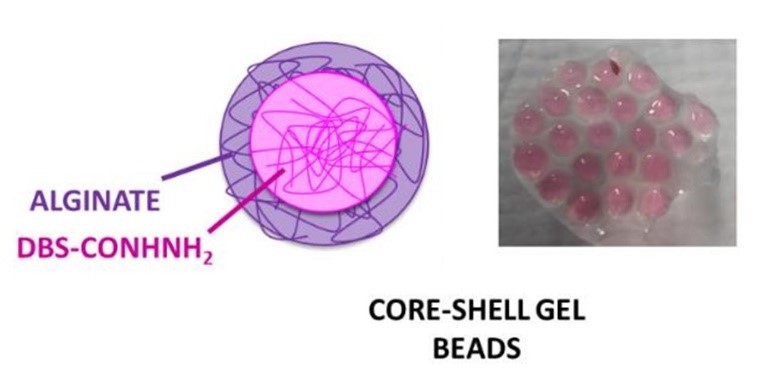Core-shell gel bead ‘doughnuts’
New research from the Smith group has discovered an innovative way of formulating functional soft gels by encapsulating them within a shell, rather like the jam filling in a doughnut.

Gels are fascinating materials that combine the properties of liquids and solids, and have a wide range of applications. As well as their well-known uses in household and personal care products, they have many potential high-tech applications.
The research group of Professor David Smith has great experience in developing gels based on the self-assembly of small molecules into an extended solid-like network that can immobilise a liquid-like phase. With funding from Engineering and Physical Sciences Research Council (EPSRC), his research team are developing such gels for applications ranging from environmental clean-up (where they can help remove pollutants from the environment) to regenerative medicine (where they can act as scaffolds for growing cellular tissue).
However, one key problem with self-assembled gels of this type is that they are often weak materials and cannot easily maintain the well-defined shapes that would be desirable for many uses.
In order to provide a solution to this shaping problem, Dr Carmen Piras, working in the lab of Professor Smith, decided to assemble the gels within a pre-formed shell. She reasoned that the more robust crosslinked polymer gel shell, based on the seaweed extract calcium alginate, would act as a mould and constrain the weaker self-assembled gel within the core – hence imposing shape and structure onto the gels. Although such shells have often been filled with different ingredients, they have never previously been filled with a self-assembling gel.
In this way, Dr Piras found that core-shell gel beads could easily and reproducibly be manufactured. Rather like a tiny doughnut filled with jam, the end result is a firm shell filled with a soft gel. Importantly, the unique properties of the gel filling give the core-shell gel beads their unique properties and characteristics, just like doughnuts.

Rather like doughnuts, it should be possible to fill the core-shell beads with many different kinds of gel filling to achieve different results.
To demonstrate that the self-assembled gel filling kept its properties, Dr Petr Slavik demonstrated that within the beads, the filling retained its unique ability to reduce precious metal ions into precious metal nanoparticles. In this way, the core-shell gel beads could remove waste palladium(II) ions from water and convert them into palladium nanoparticles, which could then catalyse Suzuki Miyaura cross-coupling reactions. Indeed, one single palladium-loaded bead could be used five times to catalyse a Suzuki reactions.
In the absence of the self-assembled gel filling, the calcium alginate shells were just not capable of effective palladium binding and catalysis. In the absence of the calcium alginate shell, the self-assembled filling was too soft to be effectively dosed into Suzuki reactions or recycled. In this way, the two components of these core-shell gel beads both play a vital role, just as in doughnuts, the shell and the jam filling cooperate to make a sweet treat that is more than the sum of its individual parts.
Professor Smith said: “The best thing about this approach is that in principle, we can fill these shells with all kinds of different self-assembled gels in order to shape them and hence better harness their unique functions, rather like filling a standard doughnut shell with various jams, curds, butters and custards. In the lab, we are therefore currently using this fabrication technique to make a wide range of core-shell gel beads for different high-tech applications.”
This research was funded by EPSRC and is published in Angewandte Chemie.